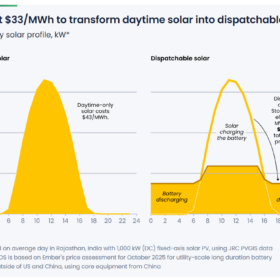As the AI revolution keeps on turning, it’s tempting for renewable energy companies to jump on the machine learning bandwagon. In many cases, it can be a smart business decision.
Still, at the end of the day, what’s going to help companies scale isn’t necessarily advanced analytics, but something decidedly less sexy: clean, normalized, site-level data.
“If you put dirty data into an AI program, it’s not going to give you any insights,” Magnus Henriksson, the chief revenue officer at renewable energy management software company Power Factors told pv magazine USA. He explained that integrating AI can have the opposite effect than intended if the underlying data isn’t clean. It’s a pit that many companies around the industry have fallen into, he explained.
“You put crap in, you get crap out, and while it’s a boring approach, you need to start by solving some of the fundamental problems first,” he said.
That primary concern? Having access to clean data at scale. A common hurdle companies run into with dirty data, Henriksson noted, is that it’s easy to miss the true problem and stick a bandaid over something that doesn’t need fixing while not addressing the real issue.
“Without quality data, mistakes happen because quality data helps with good decision-making,” added Bryan Hopper, the head of commercial at resource management firm ENGIE Impact. He told pv magazine USA that most companies build their budgets using a top-down approach that can lead to local quirks (like erratic billing cycles) getting missed.
Accurate, real-time data from across a portfolio can help companies avoid “overhedging” their energy bets, as otherwise they “make decisions based on estimations, and estimations aren’t always accurate.”
While a misestimation might not sound like it’s the stuff of nightmares, the price tag it comes with could be. Hopper noted that, particularly as climate volatility continues increasing, it’s more important than ever to understand what’s happening at a given site at relatively granular intervals.
“There can be big expenditure differences,” he said, “where maybe you budget X amount of money for your power on this day, but a heat wave hits and you end up paying X plus 10. That’s a big difference.”
Still, according to Henriksson, one of the best things that can help is updating internal software to streamline data sharing between departments.
“To be blunt, operating with spreadsheets that are siloed between teams makes you inefficient,” he said, adding that integrating standardized software frees up asset managers to prioritize tasks like improving operational performance rather than puzzling through a mess of data. Plus, this reduces the chance of human errors influencing the data.
“It lets people solve the real problem, not a data problem,” he added.
Once that’s been addressed, then integrating AI can be a more worthwhile approach, though Henriksson also cautioned that while there is a lot of potential for using generative AI and machine learning in the industry, companies need to walk before they can run.
This content is protected by copyright and may not be reused. If you want to cooperate with us and would like to reuse some of our content, please contact: editors@pv-magazine.com.









By submitting this form you agree to pv magazine using your data for the purposes of publishing your comment.
Your personal data will only be disclosed or otherwise transmitted to third parties for the purposes of spam filtering or if this is necessary for technical maintenance of the website. Any other transfer to third parties will not take place unless this is justified on the basis of applicable data protection regulations or if pv magazine is legally obliged to do so.
You may revoke this consent at any time with effect for the future, in which case your personal data will be deleted immediately. Otherwise, your data will be deleted if pv magazine has processed your request or the purpose of data storage is fulfilled.
Further information on data privacy can be found in our Data Protection Policy.